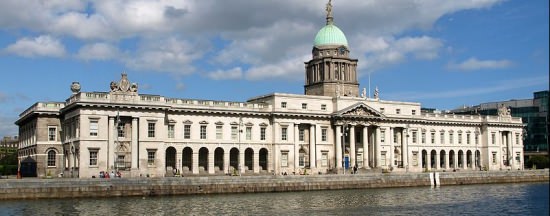A masterpiece of European neo-classicism, the building of a new Custom House for Dublin was the idea of John Beresford, who became first commissioner of revenue for Ireland in 1780. In 1781 he appointed James Gandon as architect, after Thomas Cooley, the original architect on the project, had died. This was Gandon’s first large scale commission.
The new Custom House was unpopular with Dublin Corporation and some city merchants who complained that it moved the axis of the city, would leave little room for shipping, and was being built on what at the time was a swamp. Purchase of land was delayed and proved exorbitant. The project was dogged by protests.
When it was completed and opened for business on 7 November 1791, it cost £200,000 to build. The four facades of the building are decorated with coats-of-arms and ornamental sculptures (by Edward Smyth) representing Ireland’s rivers. Another artist, Henry Banks, was responsible for the statue on the dome.
As the port of Dublin moved further downriver, the building’s original use for collecting custom duties became obsolete, and it was used as the headquarters of local government in Ireland. During the Irish War of Independence in 1921, the Irish Republican Army burnt down the Custom House, in an attempt to disrupt British rule in Ireland. Gandon’s original interior was completely destroyed in the fire and the central dome collapsed. A large quantity of irreplaceable historical records were also destroyed in the fire.
After the Anglo-Irish Treaty, it was restored by the Irish Free State government. Further restoration was done in the 1980s.
James Gandon’s architectural masterpiece now houses a fully reimagined exhibition created by award-winning designers whose previous work includes exhibitions at Killarney House and Dublin Castle, with contributions from leading Irish historians and academics, featuring a narrative journey revealing a story with many layers, of people, heritage and history, spanning over 200 years.
The exhibition flows and develops chronologically using each space to tell a chapter in the story, taking visitors from Dublin in the late 1700s through to the 21st century and giving them the unique and authentic experience of being inside the walls of one of the city’s most iconic buildings.
The new visitor experience takes visitors on a narrative journey through the building itself, highlighting the magnificent architecture and using first-hand accounts, personal stories, and artefacts to tell the story of the building and the city from the 1700s up to the present day.
The exhibition shows how the building witnessed some of the most momentous events in Irish history, from the 1916 Easter Rising to the birth of the Irish Free State and eventually the Republic of Ireland. The fulcrum of this story is the burning of the Custom House in May 1921; this event is brought to life though captivating audio visual interpretation and artefacts from the period.
Opening Hours:
Opening Hours: Open 7 days a week (including Public Holidays) from 9.30am – 5.30 pm.
The Centre is usually open from 28 – 30 December.
Closed 24 – 27 December, 31 December and 1 January.
Contact & Pricing:
heritageireland.ie/places-to-visit/custom-house-visitor-centre/
[email protected]
Tel: 046 940 7146
Custom Quay, Dublin 1
Adults €8 (guided tour); Adults €6 (self-guided); concessions
Credit/Debit card required to purchase tickets.
